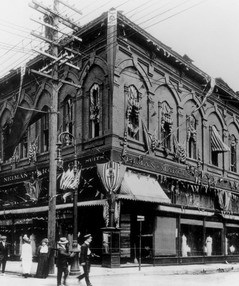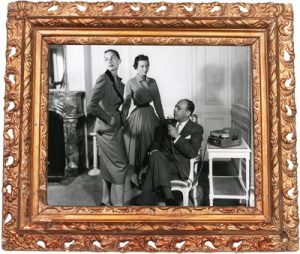For the previous 100 years, Neiman Marcus was the sophisticated embodiment of the Milan and Paris runways, staying ahead of the fashion curve as it brought cutting-edge style to its sophisticated and wealthy clientele in the U.S. Now, as it enters its second century, it acknowledges that being fashion-forward is increasingly challenging. The speed of information has become much faster.
In 1907, the year Neiman Marcus first opened its doors in Dallas, a wireless “telephonic” message sent 250 miles from Germany to Denmark was considered a technological breakthrough. The rate of communications has advanced at mach speed since then. It’s now digital, cosmic and immediate.
“In today’s global, real-time information world, the customer often knows the trends before we do,” says Ignaz Gorischek, vp, store development and visual planning. No longer does the retailer have the luxury of seeing, analyzing and digesting the trends before making its fashion offerings to an eager public. “Now, the fashions hit the runways of Europe,” says Gorischek, “and the woman in Des Moines sees it all immediately on the Internet. She downloads and sends the images to her friends on her iPhone or BlackBerry, and suddenly the whole community knows what’s going on. Now they come to us requesting the latest Gucci or Armani they saw on the runway. The challenge for us today is to stay ahead.”
So Neiman Marcus keeps doing what it always has done: knowing its customers’ aspirations, delivering superior customer service and building the best possible stores. The bright and clean ambience continues to be filled with the touches that have meant so much over the years – fresh floral is replaced daily and original artwork abounds. (Neiman Marcus is the only retailer with a full-time in-house art curator.)
Advertisement
Sure, the retailer is using this occasion of its centennial to bathe in nostalgia, recalling the solid, sensible retailing instincts of long-time president Stanley Marcus, the changing fashion looks over the decades, the ads and holiday books and fabulous customer anecdotes. But, Gorischek insists, that’s only for the moment. “All retail should be looking to tomorrow,” he says. “You can’t go forward at 120 miles per hour with your eyes on the rear-view mirror. Well, you can, but you’ll crash.”
The centennial gala in the downtown Dallas flagship store in October was an illustration of that. One of the events was an old-fashioned Texas celebration, the other a traditional black tie affair. However, the theme of it all was “Neiman Marcus: The Next 100 Years.” The fashion on display had a special forward trendiness. The retailer asked its leading designers to create what they see as the future of fashion and presented new looks in color, materials and shapes from Giorgio Armani, Zac Posen, Dolce & Gabbana and the rest. Furniture in the store was avant garde. The in-store artwork had techno applications from new media, such as digital video and interactivity.
However, the modernity of the newest Neiman Marcus stores (note the extraordinary undulating façade in the new Natick, Mass., location, featured in the November issue of VM+SD) masks the fact that this consistent retailer has the same spirit it had a century ago. The interiors are still spacious and well-lit and marked by visual hot spots – an elegant, sparsely merchandised table topped with flowers, a tasteful sculpture, a comfortable place to sit down – that make shoppers feel welcome and unrushed. “We want you in the store,” says Gorischek. “Whereas many retailers today say they are creating opportunities to get people in and out quickly, we want them to relax and stay. Our stores are like museums. You shouldn’t rush through them, you should pause and appreciate them.”
And there is, of course, that attention to service. Over 100 years, countless Neiman Marcus customers can tell a story about a salesperson going the extra mile – remembering a birthday, past purchase, preference in colors or fragrance; canvassing the entire store for an outfit that goes with a single pair of shoes; permitting a return, any time for any reason; becoming as much a personal consultant as a salesperson. “Our business is built around people who believe in the mission statement,” Gorischek says. “For us, it’s the difference between a commitment to a way of doing business versus working on commission.”
Advertisement
The mission statement is as relevant today as in 1907. The company vowed from the beginning to provide customers “with distinctive merchandise and superior service. We will offer the finest fashion and quality products in a welcoming environment.” It also stated a belief in “a selling environment that enables our associates to satisfy our customers; treating all our associates, customers and vendors with dignity and respect; and hiring and developing the best people and recognizing their achievements.”
And it continued through the years, and generations of Marcuses. Co-founder Herbert Marcus famously said, “It’s never a good sale for us unless it’s a good buy for our customer.” And his son, Stanley Marcus, said, “If you sell satisfaction, people will come back to you.”
Stanley Marcus, who ran the company for 50 years, is still honored as its spiritual soul. “When you see photography of Neiman Marcus Northpark, built in the mid-’60s, you begin to understand the vision Stanley Marcus had for his first expansion stores,” says Mike Wilkins, partner in charge at RYA Design Consultancy (Dallas) and creative director on many Neiman Marcus projects. “Eleanor LeMaire created an interior that even now, 40 years later, seems inspired and fresh. These stores have become direct references for the correct generation of stores. When you combine this ‘feel’ with the incredible merchandise, the lighting, the art and the service in the newer stores, you begin to understand why Neiman Marcus continues to be such a success.”
Former colleagues, as well, still sing the praises of Stanley Marcus. “[He] had that rare talent of igniting his customers’ imagination, their interests and desires,” says Peter Rizzo, former president of Bergdorf Goodman, now with Isaac Mizrahi. “Without that legacy, there wouldn’t be a Neiman Marcus today.”
Advertisement
“Stanley had a tremendous understanding of what quality really meant,” recalls Philip Miller, former president of Neiman Marcus who also headed up Saks Fifth Avenue and Marshall Field’s. “He often remarked that people rarely remember what they spent on an item, but they clearly remember whether it served them well.”
Even Neiman’s rivals applaud it. “Neiman Marcus understood the aspirations of the American dream, and they sought to define it materially,” says Robert Sakowitz, whose family ran a rival luxury operation in Houston. “So if you have an aspiration to be wealthy, this is what you would wear, this is what is good taste.”
“It sounds simple, but it’s not always easy,” Gorischek acknowledges. “Meeting that mission, though, has been what’s kept this company on the top of its game for 100 years.”
Photos courtesy of The Neiman Marcus Group Inc., Dallas
The Neiman Marcus century: A timeline
1907
Herbert Marcus and his sister and brother-in-law, Carrie and A.L. Neiman, pool $25,000 and open a store on Elm and Murphy streets in downtown Dallas.
1914
After a fire destroys the original site, the flagship store is rebuilt at Main and Ervay streets, where it remains today.
1926
Herbert Marcus’ oldest of four sons, Stanley, leaves Harvard Business School to become the retailer’s secretary and treasurer.
1928
A.L. Neiman divorces Carrie Marcus Neiman and sells his shares.
1950
Herbert Marcus dies at 72; Stanley Marcus becomes president.
1951
The second store opens, in Dallas’ Preston Center.
Stanley Marcus begins the Neiman Marcus Art Collection with the commissioning of an Alexander Calder mobile, “Mariposa.”
1952
Carrie Marcus Neiman dies at 69.
1969
Neiman Marcus is sold to Broadway-Hale Stores (which becomes Carter Hawley Hale).
1972
Carter Hawley Hale buys Bergdorf Goodman in New York.
1987
General Cinema (which becomes Harcourt General) acquires Neiman Marcus and Bergdorf Goodman.
1988
Allen Questrom is named chairman and ceo, the first non-Marcus to run the company. Terry Lundgren also comes on board, as evp, stores and visual presentation.
1990
Terry Lundgren succeeds Allen Questrom as ceo.
1994
Burt Tansky is named president and ceo of Neiman Marcus Stores.
1999
Harcourt General spins off Neiman Marcus and Bergdorf Goodman as The Neiman Marcus Group, with Burt Tansky as president and chief operating officer.
2002
“Mr. Stanley” dies at age 96.
Karen Katz is named president and ceo of Neiman Marcus Stores.
2005
An equity partnership (Warburg Pincus and Texas Pacific Group) acquires The Neiman Marcus Group and takes it private.
2007
The company announces five more stores in the next three years.


 Headlines6 days ago
Headlines6 days ago
 Headlines2 weeks ago
Headlines2 weeks ago
 Headlines1 week ago
Headlines1 week ago
 Headlines2 weeks ago
Headlines2 weeks ago
 John Ryan2 weeks ago
John Ryan2 weeks ago
 Sector Spotlight1 week ago
Sector Spotlight1 week ago
 Headlines2 weeks ago
Headlines2 weeks ago
 Headlines5 days ago
Headlines5 days ago




















